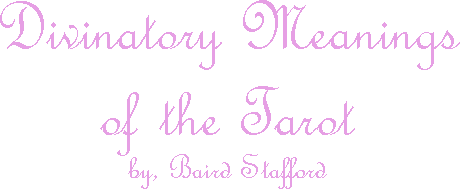
Introduction
The Tarot has been around for a long time - several centuries at
least. Over those hundreds of years, each of the cards came to
have a generally accepted meaning or set of meanings when it appeared
in a layout. If one accepts, as I do, continued use of and
belief in objects, tools, rituals and even the Powers themselves
grants added puissance (producing what the Golden Dawn terms an
"egregore"), then it makes sense to avail one's self of this added
dimension. Accordingly, I have written a series of articles on
the cards dealing with no more than their divinitory meanings. I shall not discuss the "higher" meanings of any of the cards -
not even the Triumphs (or Trumps) - and shall avoid all discussion of
the placement of the cards on the Kabbalistic Tree of Life, which
superimposition did not occur until the nineteenth century, in any
case.
The basic source from which I shall extract these meanings is A. E.
Waite's Pictoral Key to the Tarot. The "Rider-Waite Deck" based
upon his designs and the accompanying book cited above were the first
examples of either published in English to gain wide readership and
eventual acceptance. Granted, the works of Court de Gebelin,
Eliphas Levi and Papus made their appearances either earlier than
Waite's work or more or less contemporaneously, but they have the
disadvantage of having been written in French (which is not one of my
languages and therefore gives me a splitting headache when I try to
read it). All other discussions of the Tarot in English with
which I am familiar are derived in one way or another from Waite's
work: either in opposition to it, as was Crowley's Book of Thoth. or
in an effort to modify the symbolism to gratify a particular magical
or religious theory. (Waite and the Golden Dawn were by no
means immune to this temptation: I view their transposition of
the numbers of Triumphs 8 and 11, Strength and Justice, in an effort
to make them fit better on their version of the Tree of Life, with
much the same jaundiced eye that I view the lab reports of a
scientist who fudges the evidence to fit his conclusions.)
Waite was not, however, much interested in the divinitory meanings of
the cards, which he regarded as their lesser, almost negligible
attribute. He appears to have copied them more or less as they
came to him, weighted with the usage of generations of gypsies and
other common fortune-tellers who had no interest in their "higher"
meanings.
I do not, however, mean to limit myself to Waite. Other
writers during the course of this century have published insights
into the divinitory meanings which complement or expand those given
by Waite. Also, the Tarot has been my principle tool for
divination for something over a quarter of a century: any
summary such as I am attempting will necessarily be filtered through
my own experiences with the cards.
Nor shall I recommend any particular deck. There are several
currently on the market which I consider excellent, many which I
think are acceptable, some which I would purchase only if they were
the only examples available, and a few which cause me to shudder
whenever I look at them but which other people whom I respect
couldn't live without. Similarly, I shall try to avoid all
discussion of the symbolism included by any particular artist in his
or her deck: such a treatment is not germane to this summary,
nor within its scope.
Each article in the series will be designated by the number or name
of the card(s) with which it treats: i.e. "1" will discuss the
four aces, "Queen" will discuss the four queens, and the Triumphs
will be discussed each in a separate article. I shall also use
the terms "Favorable" and "Unfavorable": not all methods of reading
the cards recognize "upright" versus "reversed;" some readers prefer
to lay all the cards upright and derive unfavorable readings from the
neighboring cards. Other methods may differ even from these
two, which are the more common.
I shall make one other departure from common practice: I
prefer the name "coins" (from the French "denier") to "Pentacles" for
that suit. The latter has, for me, a patina of superimposed
mysticism (largely thanks to the Golden Dawn) which I find
unnecessary for divinitory purposes.
With luck, some of you will find this series of articles useful. Others will find areas of disagreement, while still others will
have insights of their own to offer. Maybe, among us, we can
generate enough signal to drown out some of the noise on alt.
pagan.
Blessed be,
Baird
NEXT

